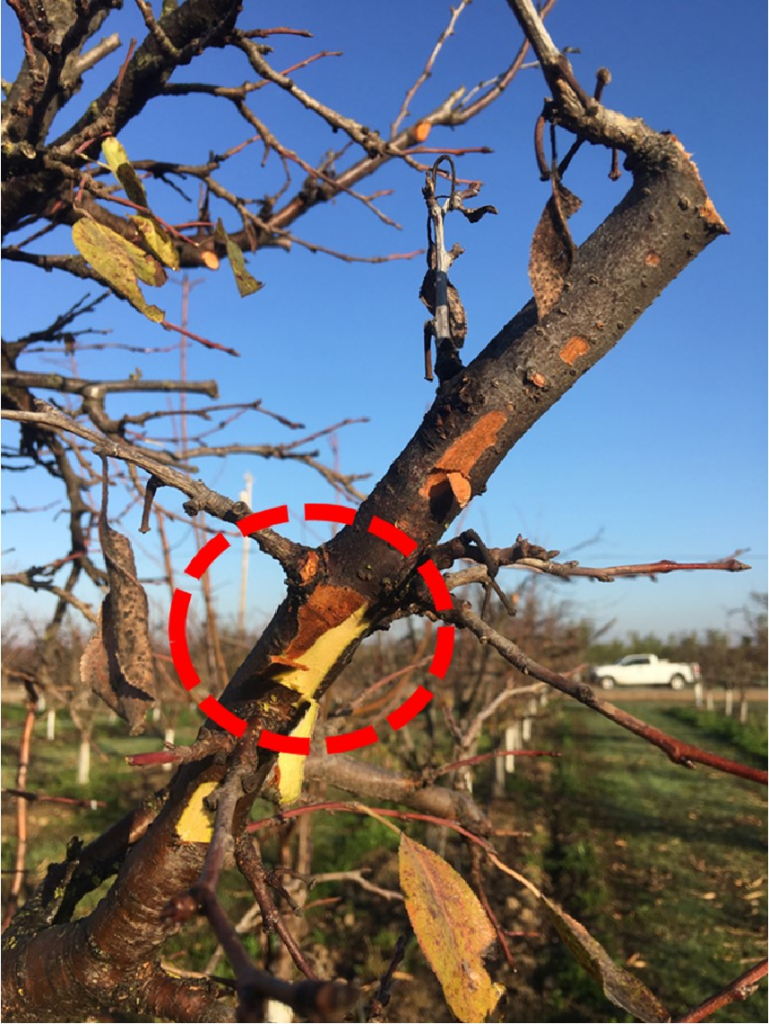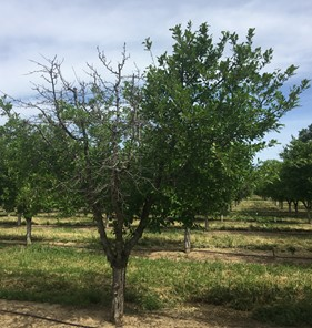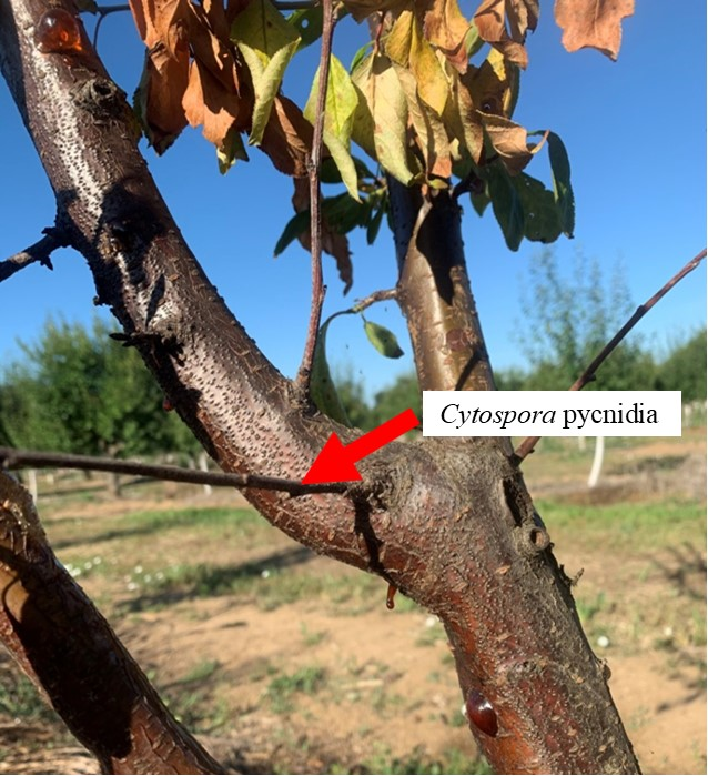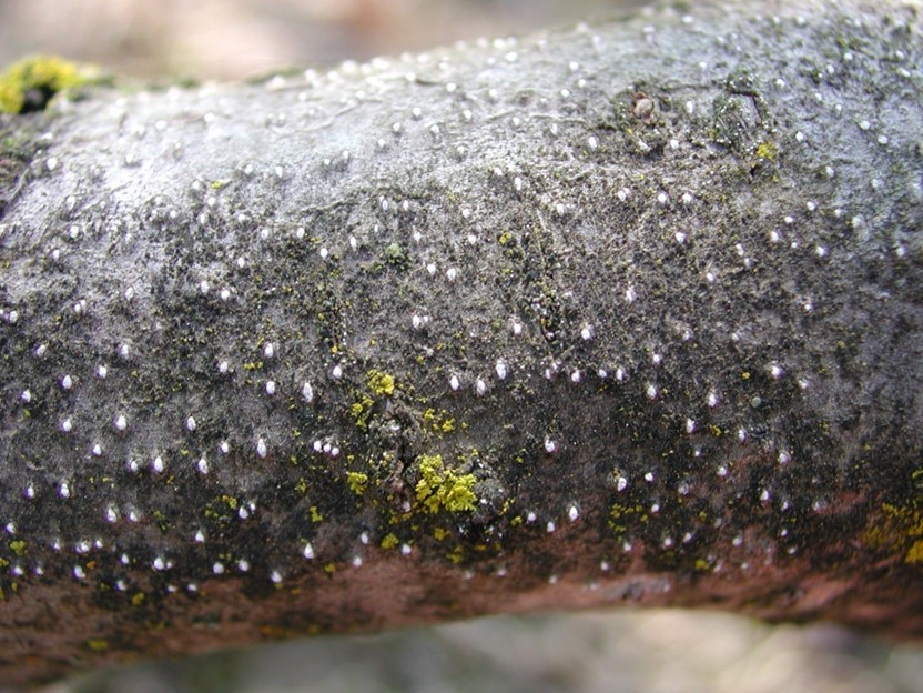Franz Niederholzer, UCCE Farm Advisor in Colusa and Sutter/Yuba Counties
LukeMilliron, UCCE Farm Advisor in Butte, Glenn and Tehama Counties
The Stakes:
Cytospora canker, caused by the fungus Cytospora leucostoma, can severely limit prune production; reducing grower income and potentially lead to early orchard removal due to scaffold and/or tree loss (see Photo 1). This bark disease is not new to prune orchards in California, but in recent years there has been a dramatic increase in this disease in some orchards. Why Cytospora has recently become more prevalent and severe is unknown. Some possible reasons include recent changes in pruning practices and warmer summer temperatures. All prune growers and PCAs working in prunes should be able to recognize the symptoms of and understand the current management recommendations for this damaging disease.
The Nemesis:
Cytospora is a so-called “weak pathogen” that needs a wound such as bark damage to enter the plant. Cytopsora invades prune trees through natural or man-made breaches in the tree’s natural protective layers. These entry points include pruning wounds, sunburned bark, and bacterial canker damage. The location of these entry points is important to how damaging an infection can be.
Cytopsora infections spread with wind and rain from dead wood killed by the canker to unprotected wounds. The source of new infections are spores produced by disease structures called pycnidia (see Photos 3 and 4). Rain is required for spore release from the pycnidia. Wind is required to carry the spores beyond the infected tree. Research shows that high winds during a rain event can carry spores up to 250 feet from a source tree. Extended rain events have a greater infection risk than short periods of rain. Infections can occur anytime rain occurs, wounds are open and disease spores are present. The first good rainstorm of the season may produce a large spore release, as the spores build up in the pycnidia over time and cannot be released without rain.
When Cytospora infection occurs near branch tips, cankers can be readily pruned out if recognized. However, when pruning wounds are low on scaffold branches, infection can spread to the crotch and trunk bark where girdling can rapidly occur. Dying trees often have diseased bark just above and below the crotch of the tree, while the bark at the top of the canopy appears healthy. These trees are effectively girdled and will not survive.
Cytospora spreads readily in prune trees under stress (heavy crop, nutrient and/or water stress) during the summer and fall. Rapid spread is possible during this period because the fungus grows most rapidly at warm temperatures (roughly 80-90oF). This means that orchards that look fine in the spring can look awful by fall.
Growth of a Nemesis:
Cytospora cankers don’t “die out” at the end of a growing season but remain in the tree from year to year. To remove Cytospora cankers from the tree, they must be cut out. Train yourself and/or pruners to recognize a good pruning cut that gets all the canker, from one that leaves the disease in the tree (see Photo 2). A copy of a pocket-sized pruning guide that can be laminated so pruners can carry it with them is available at: sacvalleyorchards.com/prunes/pruners-pocket-guide-for-cutting-out-cytospora.
University of California research, led by Dr. Themis Michailides and funded by the California Prune Board, continues to increase our understanding of the development of canker diseases in prunes in general and Cytospora in particular. He and his lab have confirmed that pruning wounds are important Cytospora infection sites. In addition, Cytospora spores were the most common canker disease in spore traps in Sutter and Yuba Counties over a three-year period. Pruning wounds are vulnerable to infection for months after the cuts were made, although the vulnerability is greater soon after pruning. Field work has documented that Topsin®-M fungicide (now with a 2EE label for pruning wound protection), applied directly to pruning wounds within a week of pruning, can reduce canker incidence. Other fungicides tested did not deliver the same, consistent results as Topsin®-M.
Why does it seem that this disease has blown up suddenly in many orchards? Why wasn’t it a bigger issue decades ago? Here are a couple of points that could help explain what is going on, as well as possible approaches to reduce damage.
- Changes in pruning practices. For decades, careful hand pruning was common in prune orchards. Skilled pruners cut out dry, dead wood (disease reservoirs) with saws as well as pruned branches and spurs with loppers. This significantly reduced the spore load in an orchard. Many growers burned prunings, eliminating any spores they contained.
- More hedging/topping. With the rise in pruning costs and limited availability of skilled pruners, many growers have moved to topping and/or hedging as a primary form of canopy management. This produces many potential infection sites. If done in the fall, when equipment can get into orchards, this practice produces multiple wounds ahead of maximum spore release. Hedging/topping is particularly risky when deep cuts are made into the canopy. Larger diameter cuts made by deep cutting take longer to heal than tipping cuts of the current year’s shoots. Hedging often does not remove all dead wood, so it leaves spore sources in trees while generating multiple potential infection sites (pruning wounds).
- Lots of interplanting: To increase production, many growers have interplanted young trees in existing orchards with wide traditional spacings. If the older trees contain a lot of Cytospora pycnidia, pruning wounds in the young tree will be at extreme risk of infection from the pycnidia just a few feet away. Learn more at: com/prunes/diseases-prunes/interplanted-orchard-hazards.
Fight Back:
What can growers do to reduce Cytospora risk in prune orchards? The following are some practices to strongly consider:
- Protect pruning wounds with Topsin®-M after pruning and before rain. This is especially important if you prune or hedge (by hand or with a machine), before the first good rain of the season. There is a pruning wound 2EE label for Rally® 40WSP in prunes, but Dr. Michailides reports that Topsin®-M is the key material to have in the tank. Tank partner inclusion of Rally® 40WSP may assist in resistance management.
- Make pruning cuts at the time of lowest infection risk. Hedge in the summer when little rainfall occurs. Delay any postharvest pruning until after the first major rains. Protect the cuts with Topsin®-M.
- Before leaf drop, send a crew through to 1) cut out dead wood and 2) remove dead wood prunings from the orchard and burn (if permitted). This timing allows crews to spot dead wood more easily than after leaf drop. If burning is not permitted, shred prunings with heavy-duty equipment (such as Flory WS910 or Rears Pul-Shredder) so that no intact pieces of wood remain. This should greatly reduce spore pressure from your orchard ahead of winter rains. This is particularly important in younger blocks where Cytospora is just getting started. Either paint the cuts with Topsin®-M or spray the whole block ahead of rain. This practice may not help as much if your up-wind neighbor doesn’t manage his/her prune trees in a similar way.
Research continues. If you have a young prune block or interplants that UC can use in a field trial of pruning timings, please contact Franz at fjniederholzer@ucanr.edu.

Photo 2. Pruning cut (upper right corner) that missed getting all the canker (inside red circle). It will keep growing down the branch.





Leave a Reply